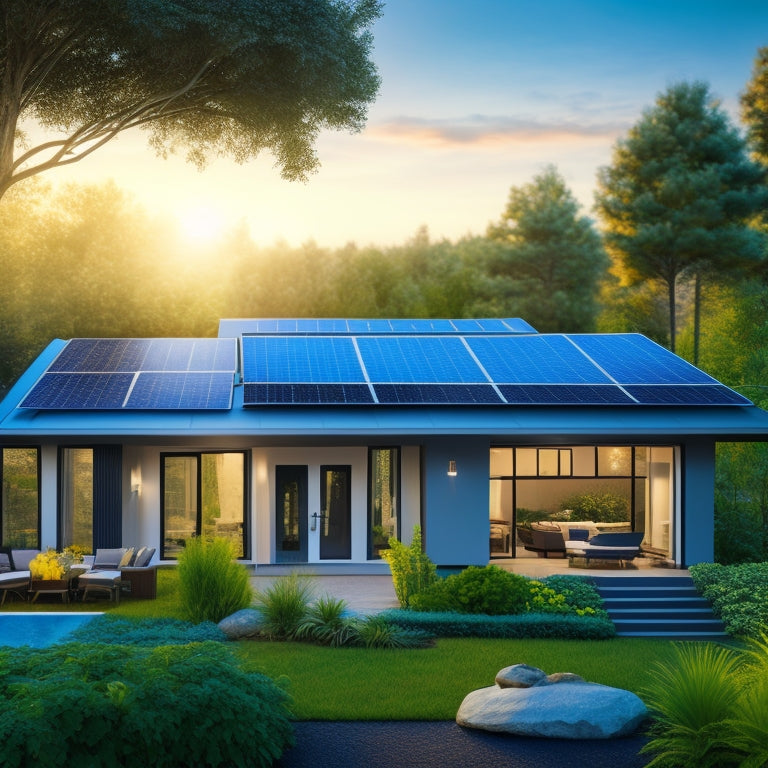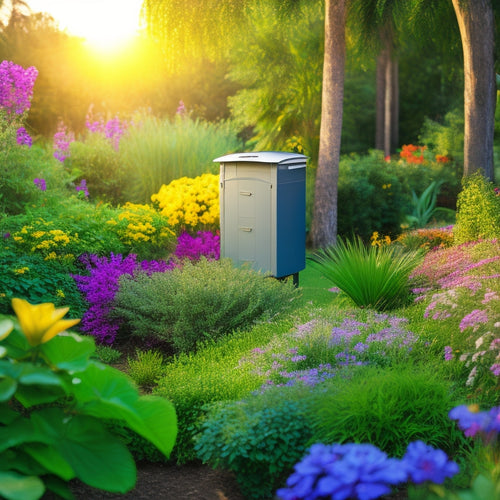
10 HVAC Efficiency Hacks for Solar-Powered Home Systems
Share
By integrating solar power into your home system, you can optimize your HVAC efficiency and maximize energy savings. To get started, optimize your thermostat settings daily, seal duct leaks, and upgrade to smart vents. Regularly schedule HVAC maintenance, balance system airflow, and use ceiling fans strategically to improve comfort while reducing energy consumption. Additionally, improve your home's insulation quality, plant trees for natural shade, and monitor your energy usage closely to identify areas for improvement. By implementing these hacks, you'll be well on your way to maximizing your solar-powered home system's efficiency - and there's even more you can do to take your energy independence to the next level.
Key Takeaways
- Optimize thermostat settings daily, aiming for a 3-5°F temperature range, and adjust when away or sleeping to reduce energy consumption.
- Seal duct leaks and upgrade to smart vents to improve airflow, reduce energy waste, and enhance overall system efficiency.
- Schedule regular HVAC maintenance, including seasonal checkups and filter replacements, to prolong system lifespan and maintain optimal performance.
- Improve home insulation quality by selecting materials with high R-values, conducting energy audits, and optimizing insulation thickness to meet local building codes.
- Strategically use ceiling fans to circulate air, enhance comfort, and reduce reliance on HVAC systems during moderate temperatures.
Optimize Thermostat Settings Daily
You wake up to a comfortable temperature every morning, thanks to your solar-powered home's HVAC system.
By optimizing your thermostat settings daily, you can maximize the system's efficiency. Start by programming your thermostat to maintain a consistent temperature throughout the day. This guarantees that your system isn't working harder than necessary to cool or heat your home.
Additionally, considering the benefits of renewable energy sources, you can further reduce your carbon footprint by utilizing solar power to decrease greenhouse gas emissions. Aim for a temperature range of 3-5 degrees Fahrenheit to maintain temperature consistency.
Additionally, consider adjusting your thermostat settings when you're away from home or sleeping to reduce energy consumption. By taking these steps, you'll be able to enjoy a comfortable living space while minimizing your energy costs and carbon footprint.
Seal Duct Leaks for Savings
You'll be surprised at how much energy is wasted through hidden duct leaks in your solar-powered home.
To maximize your HVAC system's efficiency, you'll need to detect these hidden leaks, seal gaps and cracks in the ductwork, and inspect duct connections for any signs of wear or damage.
In fact, did you know that renewable energy sources like solar and wind power can greatly reduce greenhouse gas emissions, making your home's energy system even more eco-friendly?
Detect Hidden Leaks
One of the most significant energy-wasting culprits in solar-powered homes is hidden duct leaks. You mightn't even realize they're there, but they can be draining your energy savings.
Integrating solar energy into your HVAC system can reduce grid reliance and carbon footprint reduces grid dependence, making it vital to optimize energy efficiency. Regular maintenance, including cleaning, is also essential for solar panel performance and energy efficiency.
To detect these hidden leaks, you'll need to get a little detective work done. Start by using thermal imaging to scan your ducts for temperature anomalies, which can indicate air leaks. Next, perform a pressure test to identify areas where air is escaping. This will help you pinpoint the exact locations of the leaks.
Seal Gaps and Cracks
Now that hidden duct leaks have been detected, it's time to seal the gaps and cracks to prevent heated or cooled air from escaping.
You'll need to inspect your ducts thoroughly, paying attention to joints, connections, and registers. Use weather stripping to seal gaps around doors and windows, and apply caulking techniques to fill in cracks around vents and joints.
Make sure to seal any holes or gaps in your ducts with mastic sealant or foil tape.
By utilizing energy storage solutions, you can further optimize your energy distribution and reduce peak demand charges. Effective load management also plays a vital role in minimizing energy waste.
Inspect Duct Connections
Duct connections are a common culprit when it comes to energy loss in solar-powered homes. As you inspect your duct system, look for signs of wear, damage, or improper connections. Use duct inspection techniques like visual examinations, pressure testing, and smoke testing to identify leaks.
| Duct Connection Type | Common Issues | Proper Sealing Methods |
|---|---|---|
| Flexible ducts | Kinks, tears, and loose connections | Use foil tape or mastic sealant |
| Rigid ducts | Loose joints, rust, and corrosion | Apply mastic sealant and wrap with fiberglass tape |
| Duct takeoffs | Leaks at takeoff collars | Seal with mastic sealant and wrap with fiberglass tape |
| Duct terminations | Leaks at vent hoods or grilles | Seal with mastic sealant and ascertain proper fit |
| Duct shifts | Leaks at shifts from one duct size to another | Use mastic sealant and wrap with fiberglass tape |
Proper sealing methods can help you save energy and reduce your solar-powered home's carbon footprint.
Upgrade to Smart Vents
Frequently, solar-powered homes struggle with uneven temperature distribution, a problem that can be alleviated by upgrading to smart vents.
By optimizing energy consumption patterns, smart vents can reduce energy waste and improve overall system efficiency optimizing energy consumption.
You'll experience smart vent benefits like improved air flow and reduced energy waste. Smart vents use sensors and motors to optimize air distribution, ensuring that each room receives the right amount of heated or cooled air.
This results in energy savings, as your HVAC system doesn't have to work as hard to maintain a comfortable temperature.
By upgrading to smart vents, you'll enjoy a more comfortable living space while reducing your energy consumption.
You'll have more control over your home's temperature, and your solar panels will work more efficiently.
Schedule HVAC Maintenance
Every three to five years, your HVAC system's performance begins to degrade, leading to reduced efficiency and increased energy consumption.
To avoid this, you need to schedule regular maintenance. By doing so, you'll guarantee your system runs smoothly, efficiently, and prolongs its lifespan.
Here's a maintenance checklist to follow:
-
Seasonal checkups: Perform routine checks at the start of each season to guarantee your system is prepared for the changing temperatures.
-
Filter replacements: Replace air filters every 1-3 months to prevent dust and debris buildup, which can reduce airflow and increase energy bills.
-
System inspections: Hire a professional to inspect your system annually to identify and fix any potential issues before they become major problems.
Balance System Airflow
Across your solar-powered home, uneven airflow can lead to reduced HVAC efficiency, increased energy consumption, and even premature system wear. To avoid these issues, you'll need to balance your system's airflow.
Start by identifying areas with restricted airflow, such as blocked vents or kinked ducts, and address them accordingly. Next, implement airflow balancing by adjusting the dampers and diffusers to guarantee consistent airflow throughout your home.
Consider system zoning, which allows you to control the temperature in specific areas, reducing energy waste and improving overall efficiency.
Insulate Ducts and Pipes
By optimizing airflow, you've taken an important step towards improving your solar-powered home's HVAC efficiency.
Now, it's time to tackle another vital aspect: insulating ducts and pipes.
Insulation is key to preventing heat loss and gain, which can greatly impact your system's performance.
Here are three essential tips to get you started:
-
Use thermal barrier materials: Wrap ducts with materials like fiberglass, rock wool, or reflective insulation to minimize heat transfer.
-
Seal all gaps and joints: Guarantee a tight seal around connections, vents, and pipes to prevent air leaks and heat escape.
-
Apply duct insulation techniques: Use techniques like wrapping, sleeving, or boxing to insulate ducts in unconditioned spaces like attics, basements, or crawlspaces.
Use Ceiling Fans Strategically
Out of the many HVAC efficiency hacks for solar-powered homes, strategically using ceiling fans can be a game-changing factor.
You can optimize your ceiling fan placement to maximize air circulation and reduce your reliance on air conditioning. During the summer, run your ceiling fan in a counterclockwise direction to push cool air down to the floor, making your home feel cooler.
In the winter, switch the direction to clockwise to circulate warm air, reducing the need for heating. This multi-season usage allows you to reap the benefits of ceiling fans year-round.
Improve Home Insulation Quality
Properly insulated homes can considerably reduce heat gain during summer and heat loss during winter, allowing your solar-powered HVAC system to work more efficiently.
To achieve ideal insulation, you should:
-
Select the right insulation materials: Choose materials with high R-values, and consider radiant barriers, reflective barriers, and air barriers for maximum energy efficiency.
-
Conduct an energy audit: Identify areas of thermal bridging and moisture control issues, and address them with targeted solutions.
-
Optimize insulation thickness: Verify that your insulation meets local building codes, and consider additional soundproofing techniques to minimize heat transfer.
Plant Trees for Natural Shade
Around your solar-powered home, strategically planted trees can serve as a natural barrier, filtering the sun's intense rays during peak hours and reducing the need for your HVAC system to work overtime. By selecting the right tree types, you can maximize shade benefits while considering seasonal growth and ecosystem impact.
| Tree Placement | Shade Benefits | Ecosystem Impact |
|---|---|---|
| South-facing windows | Reduces summer heat gain | Supports wildlife habitats |
| West-facing windows | Blocks intense afternoon sun | Improves soil health |
| East-facing windows | Softens morning sunlight | Enhances climate resilience |
Proper tree placement can also improve air quality, mitigate urban heat islands, and create a thriving ecosystem around your home. By incorporating trees into your solar-powered home system, you'll enjoy a more comfortable and sustainable living space.
Monitor Energy Usage Closely
You'll want to keep a close eye on your energy usage to optimize your HVAC system's performance.
To do this, you can set up daily energy reports to track your consumption patterns and identify areas for improvement.
Daily Energy Reports
With the average solar-powered home generating a significant amount of clean energy, it's crucial to monitor and manage that energy efficiently. You can do this by reviewing daily energy reports, which provide useful observations into your daily consumption and usage patterns.
These reports help you identify areas of inefficiency, allowing you to make adjustments and optimize your energy usage.
Here are three key benefits of daily energy reports:
-
Identify energy-hungry appliances: Daily reports help you pinpoint which appliances are consuming the most energy, enabling you to replace them with more efficient alternatives.
-
Optimize your energy usage: By analyzing your daily consumption patterns, you can adjust your energy usage to match your solar power generation.
-
Maximize your energy independence: With daily energy reports, you can ascertain you're using your solar power efficiently, reducing your reliance on the grid and maximizing your energy freedom.
Track Real-Time Data
Monitor your energy usage closely by tracking real-time data, giving you an unparalleled level of control over your solar-powered home's energy efficiency. This allows you to identify areas of improvement and make data-driven decisions to optimize your system. With real-time monitoring, you'll gain understanding into performance trends, usage forecasting, and energy analytics.
| Benefits | Features |
|---|---|
| Data Visualization | Real-time monitoring, Efficiency metrics |
| System Integration | Performance trends, Usage forecasting |
| Predictive Maintenance | Energy analytics, Identifying areas of improvement |
Frequently Asked Questions
Can I Use Solar Power to Heat My Pool?
Like Apollo utilizing the sun's power, you can tap into solar energy to heat your pool, slashing energy bills and enjoying a warm oasis while basking in the freedom of sustainable living, thanks to solar pool heating's impressive energy savings.
Do Solar Panels Work During Power Outages?
You're wondering if solar panels work during power outages? Typically, they don't, as most systems are grid-tied and shut down for safety reasons. However, you can opt for battery backup systems or islanding inverters for continuous solar panel functionality and power outage solutions.
Can I Install Solar Panels on a Metal Roof?
You're likely to save 30% on energy costs with solar panels, and yes, you can install them on a metal roof, leveraging its benefits like durability and ease of installation, making the process smoother and more efficient.
Are Solar-Powered HVAC Systems Eligible for Tax Credits?
You're eligible for solar tax credits, which cover 26% of your solar-powered HVAC system's cost, plus additional HVAC incentives, providing significant savings; consult with a tax professional to maximize your return on investment.
Can I Add Solar Panels to an Existing HVAC System?
As you commence on this energy independence expedition, you can retrofit your existing HVAC system with solar panels, seamlessly integrating them to access significant HVAC energy savings, and taking a giant leap towards a freer, more sustainable tomorrow.
Related Posts
-

3 Best Solar-Powered Biodegradable Accessories for Your Home
You're taking a significant step towards a more sustainable lifestyle by incorporating solar-powered biodegradable ac...
-

3 Earth-Loving Furniture Tips for Energy-Smart Homes
When furnishing your energy-smart home, you have the power to reduce your carbon footprint greatly by making consciou...
-

Why Choose Solar Composting Toilets for Your Home?
By choosing a solar composting toilet for your home, you'll greatly reduce your environmental impact, slashing your w...


